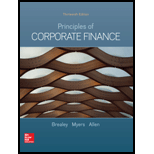
Principles of Corporate Finance
13th Edition
ISBN: 9781260465099
Author: BREALEY, Richard
Publisher: MCGRAW-HILL HIGHER EDUCATION
expand_more
expand_more
format_list_bulleted
Question
Chapter 29, Problem 6PS
Summary Introduction
To determine: The impact of each transaction on cash cycle.
Cash cycle is the overall circulation or cycle of cash commences from the payment of raw materials and ends with receipt of cash on goods sold.
Expert Solution & Answer
Want to see the full answer?
Check out a sample textbook solution
Students have asked these similar questions
Jeff Krause purchased 1,000 shares of a speculative stock in January for $1.89 per share. Six months later, he sold them for $9.95 per share. He uses an online
broker that charges him $10.00 per trade. What was Jeff's annualized HPR on this investment?
Jeff's annualized HPR on this investment is %. (Round to the nearest whole percent.)
Congratulations! Your portfolio returned 16.7% last year, 2.5% better than the market return of 14.2%. Your portfolio had a standard deviation of earnings equal to
18%, and the risk-free rate is equal to 4.4%. Calculate Sharpe's measure for your portfolio. If the market's Sharpe's measure is 0.29, did you do better or worse than
the market from a risk/return perspective?
The Sharpe's measure of your portfolio is
(Round to two decimal places.)
On January 1, 2020, Simon Love's portfolio of 15 common stocks had a market value of $258,000. At the end of May 2020, Simon sold one of the stocks, which had
a beginning-of-year value of $26,900, for $31,400. He did not reinvest those or any other funds in the portfolio during the year. He received total dividends from stocks
in his portfolio of $11,900 during the year. On December 31, 2020, Simon's portfolio had a market value of $246,000. Find the HPR on Simon's portfolio during the
year ended December 31, 2020. (Measure the amount of withdrawn funds at their beginning-of-year value.)
Simon's portfolio HPR during the year ended December 31, 2020, is %. (Round to two decimal places.)
Chapter 29 Solutions
Principles of Corporate Finance
Ch. 29 - Sources and uses of cash State whether each of the...Ch. 29 - Sources and uses of cash Table 29. 11 shows...Ch. 29 - Prob. 3PSCh. 29 - Sources and uses of cash and working capital...Ch. 29 - Prob. 5PSCh. 29 - Prob. 6PSCh. 29 - Cash cycle A firm is considering several policy...Ch. 29 - Collections on receivables Here is a forecast of...Ch. 29 - Collections on receivables If a firm pays its...Ch. 29 - Forecasts of payables Dynamic Futon forecasts the...
Ch. 29 - Cash budget Table 29.13 lists data from the budget...Ch. 29 - Short-term financial plans a. Paymore places...Ch. 29 - Short-term financial plans Which items in Table...Ch. 29 - Short-term financial plans Work out a short-term...Ch. 29 - Prob. 16PSCh. 29 - Prob. 17PSCh. 29 - Long-term financial plans Corporate financial...Ch. 29 - Prob. 19PSCh. 29 - Prob. 20PSCh. 29 - Long-term financial plans Construct a new model...Ch. 29 - Long-term financial plans a. Use the Dynamic...Ch. 29 - Long-term financial plans Table 29.15 summarizes...Ch. 29 - Long-term financial plans Abbreviated financial...Ch. 29 - Prob. 25PSCh. 29 - Forecast growth rate What is the maximum possible...Ch. 29 - Forecast growth rate a. What is the internal...Ch. 29 - Forecast growth rate Bio-Plasma Corp. is growing...Ch. 29 - Long-term plans Table 29.18 shows the 2019...
Knowledge Booster
Similar questions
- Chee Chew's portfolio has a beta of 1.27 and earned a return of 13.6% during the year just ended. The risk-free rate is currently 4.6%. The return on the market portfolio during the year just ended was 10.5%. a. Calculate Jensen's measure (Jensen's alpha) for Chee's portfolio for the year just ended. b. Compare the performance of Chee's portfolio found in part a to that of Carri Uhl's portfolio, which has a Jensen's measure of -0.25. Which portfolio performed better? Explain. c. Use your findings in part a to discuss the performance of Chee's portfolio during the period just ended.arrow_forwardDuring the year just ended, Anna Schultz's portfolio, which has a beta of 0.91, earned a return of 8.1%. The risk-free rate is currently 4.1%, and the return on the market portfolio during the year just ended was 9.4%. a. Calculate Treynor's measure for Anna's portfolio for the year just ended. b. Compare the performance of Anna's portfolio found in part a to that of Stacey Quant's portfolio, which has a Treynor's measure of 1.39%. Which portfolio performed better? Explain. c. Calculate Treynor's measure for the market portfolio for the year just ended. d. Use your findings in parts a and c to discuss the performance of Anna's portfolio relative to the market during the year just ended.arrow_forwardNeed answer.arrow_forward
arrow_back_ios
SEE MORE QUESTIONS
arrow_forward_ios
Recommended textbooks for you
 Intermediate Financial Management (MindTap Course...FinanceISBN:9781337395083Author:Eugene F. Brigham, Phillip R. DavesPublisher:Cengage Learning
Intermediate Financial Management (MindTap Course...FinanceISBN:9781337395083Author:Eugene F. Brigham, Phillip R. DavesPublisher:Cengage Learning

Intermediate Financial Management (MindTap Course...
Finance
ISBN:9781337395083
Author:Eugene F. Brigham, Phillip R. Daves
Publisher:Cengage Learning